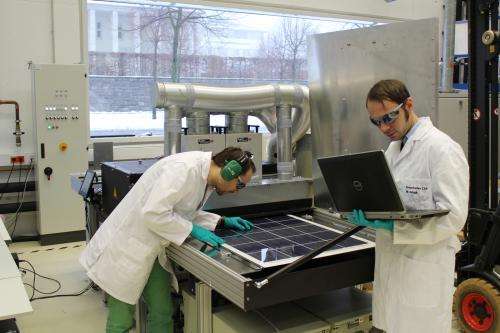Embedding photovoltaic modules more quickly

The market for solar modules is highly competitive. For this reason, companies must save on costs, such as by using a new process. It embeds the cells twice as fast into their protective plastic sheathing – and therefore saves time and money.
Solar cells must endure a lot: snow, hot summer days, rain and humidity. To provide maximum protection to the cells, the manufacturers embed them in plastic, usually in ethylene vinyl acetate (EVA). The principle is that they laminate the cells in the first step. For this, they encase the cells in a plastic film and heat it up. Once the plastic is soft, the entire stack is pressed together in the laminator so that it flows well around the cells and encases them. This process vulcanizes the plastic – in other words, it crosslinks it (meaning that a type of rubber is created). The advantage is that the material can no longer be melted once it is in this state; it is more stable and protects the cells better against mechanical and thermal stress. For the crosslinking, the solar cell plastic stack is heated in the vacuum laminator to a temperature of up to 150 degrees Celsius; this high temperature provides the "starting signal" for the crosslinking. The processing times for the vulcanizing are rather long, however the stack of cells must remain in the laminator for about 20 minutes, sometimes even longer, driving production costs up.
Less than eight minutes for laminating
The manufacturers can counteract this cost pressure on either the process or the materials side, meaning you are able to optimize the process yourself or use better materials. Scientists from the Fraunhofer Center for Silicone Photovoltaics CSP in Halle will, from now on, support manufacturers on the process side jointly with colleagues from LANXESS: "We have modified the lamination process so that it only takes about 7 to 8 minutes instead of 20 minutes. We were therefore able to reduce the duration of the total process by more than 50 percent," says Dr. Stefan Schulze, Polymer Materials Team Leader at CSP. "In comparison to the standard process we are therefore able to laminate twice as many modules on one system, which directly positively affects the production costs per module."
The researchers were inspired by printing ink for news prints, which vulcanize in a few seconds after being exposed to a UV light. The crosslinker used by LANXESS worked in the same manner – activated by UV radiation instead of by high temperatures, it crosslinks the plastic within a few seconds while maintaining the same quality. The reason for that were the plastic films. If the usual additives are used in the plastic, then care must be taken when mixing the ingredients to always stay below the crosslinking temperature – meaning that the mixing has to be carried out very gently. For this reason, the resulting film is often not very homogenous. "However, if we crosslink the additives using UV radiation we are able to mix aggressively. We therefore achieve homogenous films and thus an improved crosslinking of the plastic," Schulze makes clear.
The researchers at CSP developed the UV crosslinking process within the Fraunhofer Innovation Cluster SolarPlastics. They are looking for answers to the following questions: How can the process be controlled? What temperatures are required? And how much radiation is required? The LANXESS employees took care of the material, meaning the composition and the type and amount of the UV crosslinker. The CSP already has a pilot plant for crosslinking where the scientists are optimizing the four parameters – the amount of radiation, the temperature, the height of the lamp and the feed rate at which the modules traverse under the UV lamps. "The process is operational," says Schulze. Interested manufacturers need not fear high costs for retrofitting their production facilities; only one UV lamp would have to be added.
Provided by Fraunhofer-Gesellschaft





















